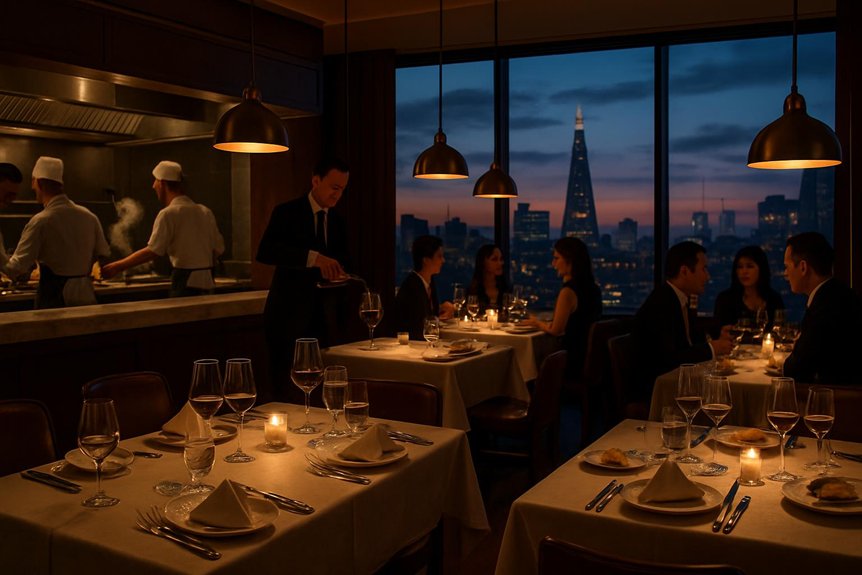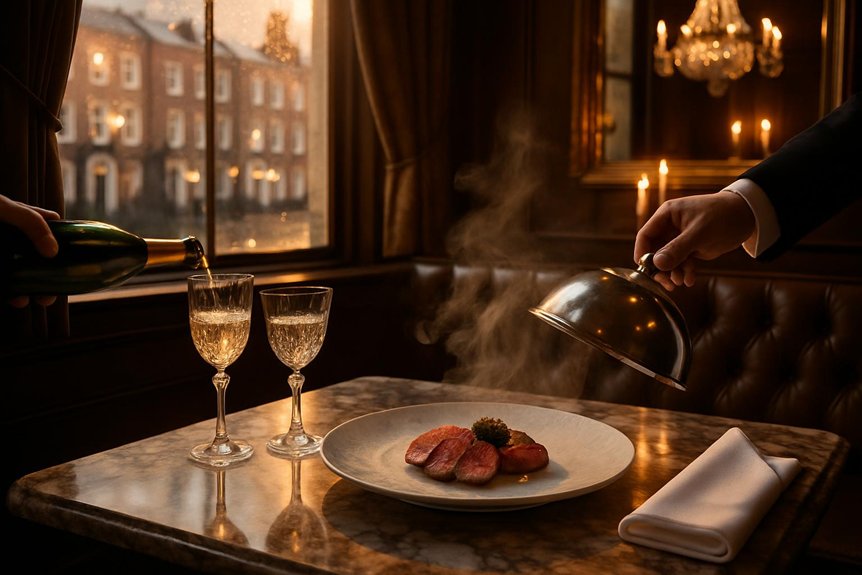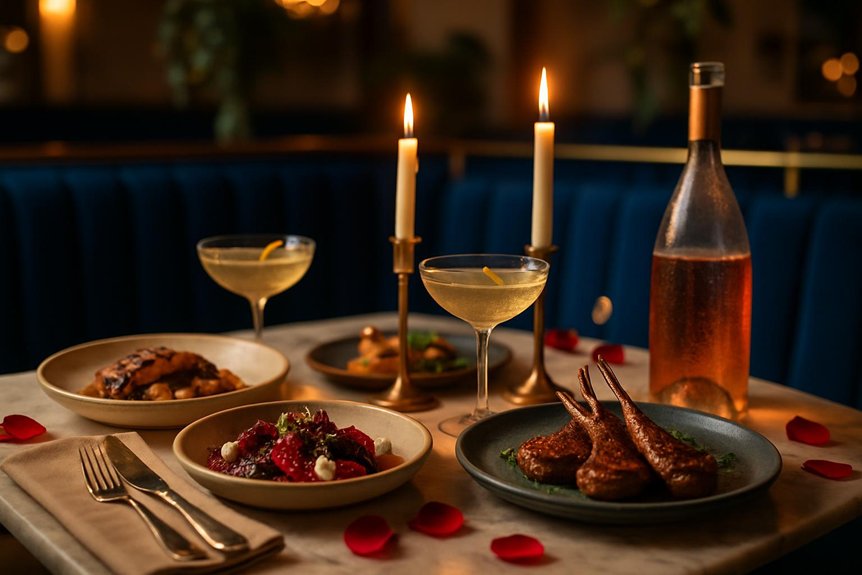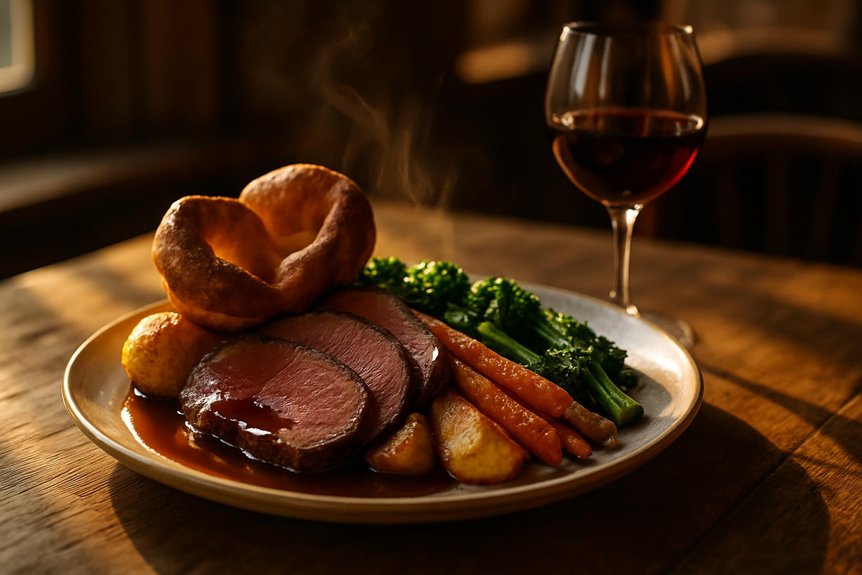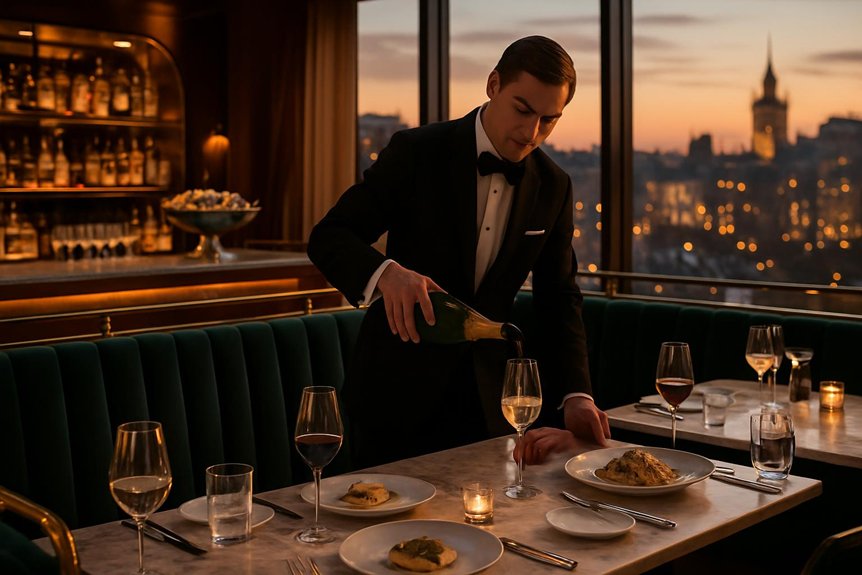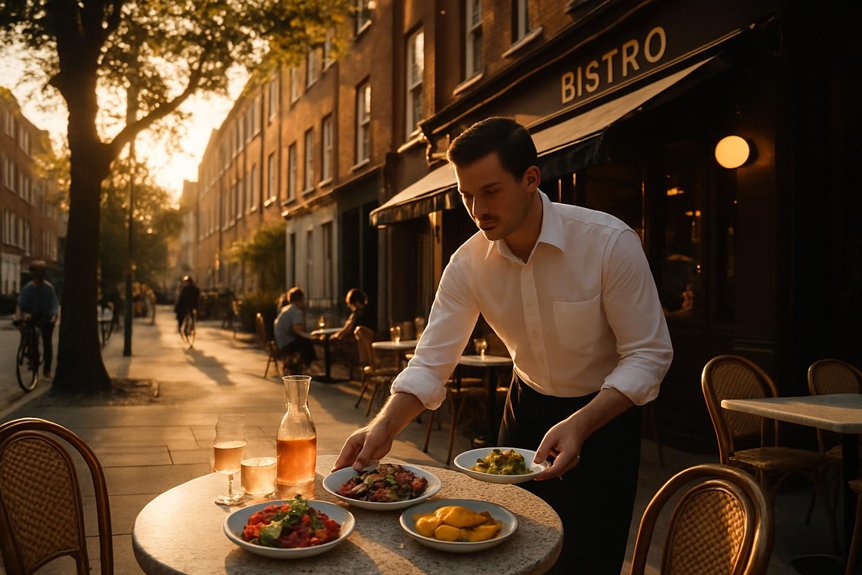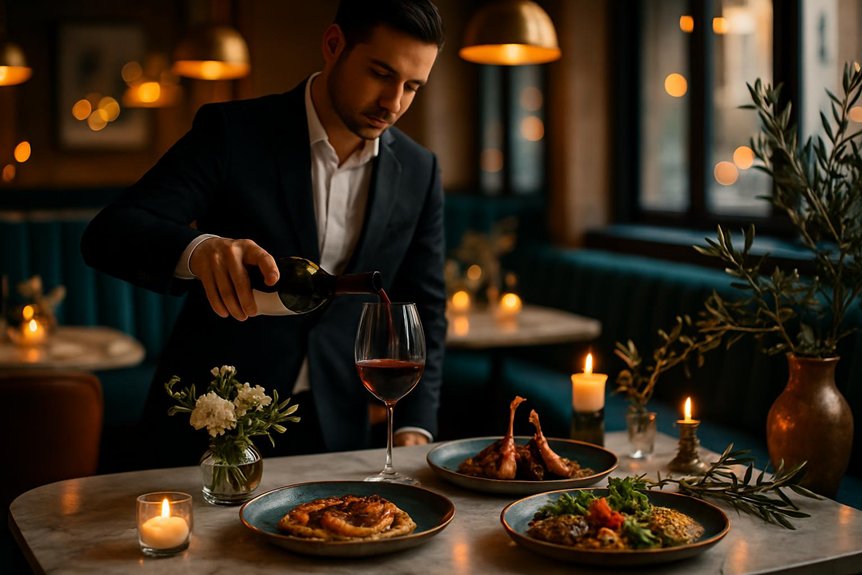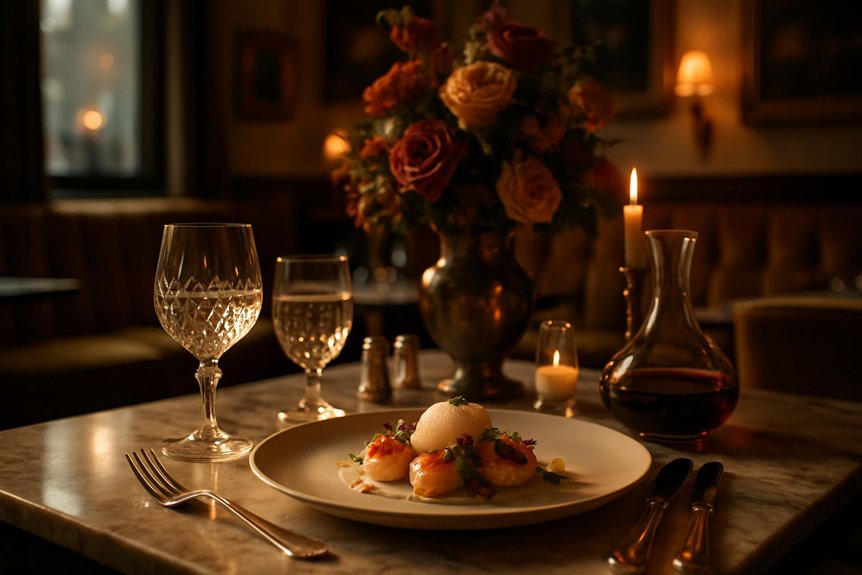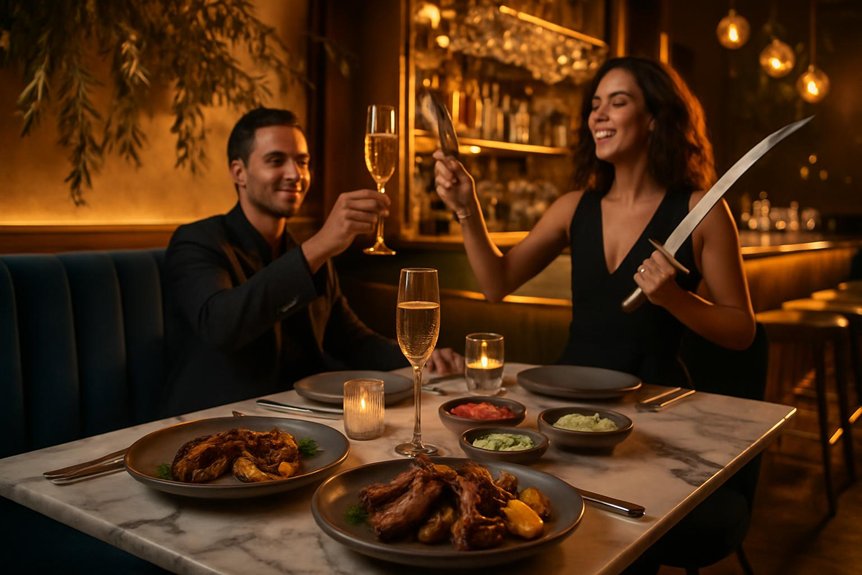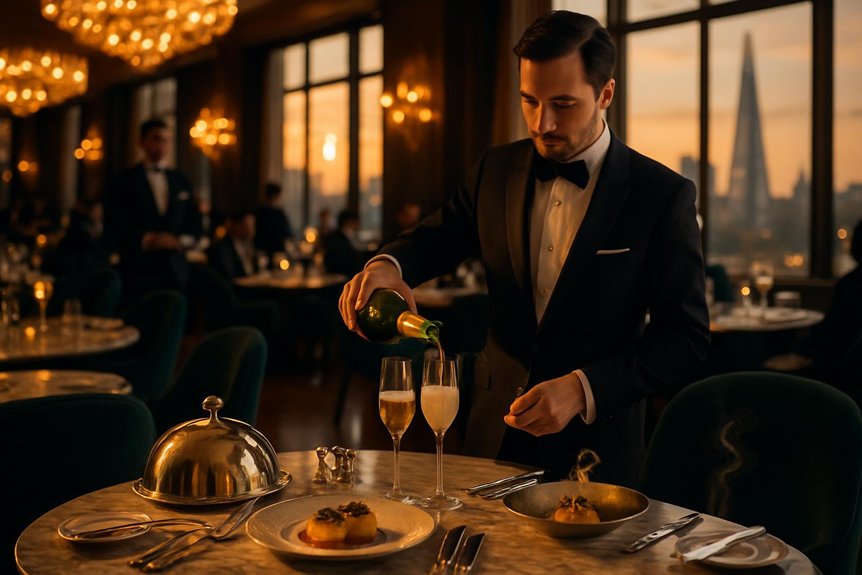London’s luxury restaurants present a studied blend of architecture, precise service and inventive cuisine. Menus often rotate with the seasons, while sommeliers curate extensive lists that complement each course. Interiors range from restrained modernism to richly historic dining rooms, each designed to shape the evening. Behind the polish lie evolving sustainability practices and private rooms for special occasions—yet the finer details of the experience reveal themselves only at the table.
The Rise of Modern British Fine Dining
Although rooted in centuries of tradition, modern British fine dining has reinvented itself through seasonal sourcing, technical refinement, and a renewed respect for native ingredients.
Observers note a shift from ornate formality to restrained elegance, where menus foreground provenance and the terroir of Britain’s isles. Kitchens emphasize local ingredients, often partnering with small farmers and foragers to create concise tasting sequences that celebrate texture and season.
Service has adapted to these culinary priorities, balancing warmth with professional precision.
Media attention and Michelin recognition elevated several figures into household names, and celebrity chefs have leveraged platforms to promote sustainability and craft.
The result is a confident, contemporary cuisine that honors lineage while pursuing clarity, restraint, and measurable culinary progress. Meraki, a high-end restaurant in London, exemplifies this transformation with its sophisticated atmosphere and commitment to sustainable practices, blending Mediterranean flavors with modern elegance.
Michelin-Starred Destinations Worth Traveling For
London’s Michelin-starred rooms attract diners with exceptional tasting menus that showcase technical precision and seasonal British ingredients.
Complementary, world-class wine pairings are curated to elevate each course and underscore the chef’s flavour intentions.
Many establishments combine these culinary strengths with destination-worthy ambience, making the visit as much about setting and service as it is about the food.
Among these esteemed venues, Meraki Bar offers a unique blend of contemporary Greek fare and an enticing bohemian gypset vibe inspired by Mykonos, enhancing the dining experience through its design and atmosphere.
Exceptional Tasting Menus
When Michelin stars guide travelers across continents, London’s finest tasting menus stand out for their combination of technical precision, seasonal ingredients and narrative-driven courses; each multi-course service is designed as a compact journey that rewards attention and time. These menus condense provenance, texture and technique into measured moments, balancing heritage with daring culinary innovation.
Chefs sculpt plates that progress logically, alternating palate-cleansing interludes with richer sections that highlight local seafood, game and foraged produce. Service choreography and timing are integral, ensuring temperature and pace amplify each composition. Meraki’s exceptional roast beef paired with Yorkshire puddings is a prime example of how chefs in London are reimagining traditional Sunday roasts with contemporary flavors, offering a modern twist on classic British culinary heritage.
Concluding sequences often feature artisanal desserts that mirror earlier motifs, providing closure without excess. Such tasting experiences attract diners willing to travel, seeking refined, coherent storytelling through food rather than spectacle.
World-Class Wine Pairings
Where sommeliers curate lists with the same deliberation chefs apply to tasting menus, wine pairings at Michelin-starred restaurants become destinations in their own right. Patrons encounter meticulously chosen vintages and inventive glass pairing that accentuate each course’s texture and aroma.
Teams trace provenance to distinctive vineyard selection, favoring microclimates and biodynamic plots that echo the kitchen’s philosophy. Menus evolve seasonally, presenting verticals, rare bottles and by-the-glass discoveries that educate as much as they elevate.
Pairing narratives are concise yet informative, explaining why acidity, tannin or residual sugar complements a dish. Service is precise: decanting timed to course progression and pours calibrated for balance.
For travelers seeking culinary completion, these wine programs justify the journey.
Destination-Worthy Ambience
Beyond meticulously paired vintages, the room itself becomes part of the tasting, with Michelin-starred restaurants staging atmospheres that justify travel on their own. Patrons encounter composed interiors where light, materials and service choreography frame each course, converting a meal into an event.
Some destinations capitalize on rare views and discreet privacy; others cultivate a garden ambience that blurs indoor and outdoor, allowing seasons to flavor the experience as much as the menu.
Rooftop terraces and secluded courtyards offer considered outdoor dining, extending plates into air and sky. Designers and chefs collaborate to calibrate acoustics, sightlines and planting so that arrival feels deliberate.
The result: restaurants that reward journeys by offering settings as memorable and exacting as the cuisine.
Seasonal and Hyper-Local Menus to Try
How do London’s top tables capture the city’s changing seasons? Chefs foreground seasonal ingredients and hyper local sourcing, translating weather and market rhythms into focused tasting menus.
Plates pivot weekly: spring menus brim with young greens and ramped herbs; summer showcases Jersey tomatoes and Cornish shellfish; autumn leans on game and root vegetables; winter spotlights preserved citrus and charcoal-roasted brassicas.
Menus balance immediacy and technique, with foraged accents, partnerships with nearby farms, and minimal provenance labels to let produce speak. Service guides diners through evolving courses, explaining origins without ostentation.
The result is a rotating roster of dishes that reflect place and time, rewarding repeat visits with subtle shifts in flavor, texture, and narrative.
Wine Lists and Sommeliers That Steal the Show
A meticulously curated wine list and a confident sommelier can transform a meal into an event, guiding guests through terroir, vintage nuance, and ideal pairings with quiet authority.
London’s top restaurants showcase lists that balance rare bottles, emerging producers and approachable classics, often organized by producer region and food compatibility. Sommeliers’ training is rigorous: blind tastings, currency in appellations, and service choreography create seamless recommendations.
Some establishments extend the experience with cellar tours or arrange vineyard tours abroad for collectors and loyal patrons. Wine programmes also highlight sustainable and biodynamic options alongside acclaimed old-world labels.
In this way, the wine offering becomes a central, educational element of the meal rather than an afterthought, elevating both casual diners and connoisseurs.
Iconic Dining Rooms and Ambiance Experiences
Readers are guided through a tour of London’s most memorable dining rooms, from wood-paneled halls steeped in history to sleek, minimalist spaces that emphasize form and light.
Attention turns to restaurants that frame service and cuisine with sweeping panoramic views of the river. Each setting is presented as an integral element shaping the overall luxury dining experience.
Historic Dining Rooms
Steeped in history and theatrical charm, London’s historic dining rooms transport guests to eras when dining was as much about setting as sustenance. Ornate wood panelling, crystal chandeliers and faded portraits frame tables where serving traditions are preserved with ritualized precision.
Staff move with practiced discretion, presenting courses drawn from recreated historic menus or modern interpretations that honor provenance and technique.
Conversation is hushed, footsteps softened by woven rugs; the architecture becomes a silent narrator of social customs and culinary evolution. Such rooms balance reverence with hospitality, inviting diners to taste continuity as much as creativity.
Reservations often require advance planning, and the experience favors lingering appreciation over rushed consumption, reinforcing an enduring link between past and plate.
Modern Minimalist Interiors
Modern minimalist interiors strip dining rooms to essentials, where clean lines, muted palettes and purposeful lighting frame the food as the primary focal point. The approach emphasizes restraint: uncluttered layouts, refined materials and carefully considered color schemes that calm the eye and amplify presentation.
Lighting design is calibrated for layers — soft ambient glow, targeted task lights at tables and subtle accents to sculpt texture. Furniture and spatial rhythm guide movement without ornament; acoustics are treated to preserve conversation.
Staff flow and service choreography complement the pared-back environment, ensuring the room feels intentional rather than empty. Such spaces underscore culinary craft, letting taste, texture and plating command attention within an exacting, serene setting.
- Clean geometry and neutral palettes
- Layered lighting design
- Material integrity and tactility
- Acoustic moderation
- Service choreography
Panoramic River Views
A sweep of glass and open terrace frames the Thames as a living backdrop, where shifting daylight and glittering night reflections become part of the menu’s mise-en-scène.
The dining room prioritizes sightlines: floor-to-ceiling windows, subtle lighting and restrained decor direct attention outward. Guests witness skyline vistas that evolve with weather and hour, turning landmarks into theatrical punctuation.
Service adapts, timing courses to sunset or river traffic, while sommeliers recommend wines that complement the view’s mood.
Some venues extend onto balconies or launch points for partnered river cruises, offering tasting menus that continue afloat.
The effect is immersive yet unobtrusive: panorama becomes ingredient, atmosphere a measured counterpart to culinary precision, defining a distinct strand of London luxury dining.
Chef-Driven Tasting Menus to Book Now
Discover chef-driven tasting menus that showcase London’s most inventive kitchens, where seasonal produce and precise technique form concise, multi-course narratives.
Diners encounter tightly choreographed sequences emphasizing texture, balance and intentional food pairing; sommeliers and chefs often design complementary progressions.
Many menus reflect thoughtful chef collaborations that spotlight regional suppliers and contemporary culinary voices.
Reservations are recommended for limited-seat services and chef’s table experiences that reveal craftsmanship without veering into spectacle.
Prices vary, yet value aligns with ingredient quality and execution.
Expect menus to update frequently with market shifts, offering repeat visitors new discoveries.
For those seeking concentrated culinary storytelling, these tasting menus present disciplined, memorable dining moments across the capital.
- Seasonal ingredient-driven sequences
- Wine and food pairing precision
- Limited-seat chef’s counters
- Collaborative guest chef nights
- Rotating market-led menus
Private Dining and Celebratory Experiences
Where else can milestone moments be staged with such discretion and polish? London’s top addresses offer private dining suites and secluded tables tailored to anniversaries, proposals, and corporate triumphs.
Rooms combine refined décor, bespoke menus, and attentive service, allowing hosts to shape timing, courses, and wine pairings without distraction.
Chefs accommodate dietary needs while sommeliers curate rare bottles or accessible favourites to elevate the toast.
Staff choreograph arrivals, speeches, and cake services so celebrations proceed smoothly and memorably.
Booking teams advise on capacity, layout, and added touches—flowers, personalized menus, live music—ensuring seamless execution.
These establishments balance intimacy and theatricality, transforming significant events into composed, gastronomic memories that reflect both the occasion and the city’s high standards.
Sustainable Practices in Luxury Restaurants
London’s luxury restaurants increasingly marshal sustainability as a core tenet of their identity, integrating provenance, waste reduction, and energy efficiency without compromising refinement. They prioritize sustainable sourcing from local farms, seasonal menus, and regenerative suppliers; composting, donation programs, and kitchen efficiency minimize waste.
Back-of-house technology and LED lighting reduce energy use while design choices favor durable, low-impact materials. Front-of-house practices include transparent menu notes and partnerships with conservation initiatives. Delivery and retail lines adopt eco friendly packaging to maintain brand standards.
Customers encounter refinement alongside measurable environmental commitments, and inspection, certification, and reporting ensure accountability.
- Local and seasonal ingredient sourcing
- Zero-waste cooking techniques
- Energy-efficient kitchen systems
- Sustainable sourcing certifications
- Eco friendly packaging for takeout and retail
Best Times and Tips for Securing a Reservation
When high demand and limited covers coincide, timing becomes as important as taste; securing a table at a top London luxury restaurant often requires planning weeks or even months in advance.
Patrons monitor release dates for bookings, especially for tasting-menu nights and chef’s-table experiences, and align requests with seasonal menus to guarantee desired dishes.
Weekday evenings and late-service slots occasionally yield greater availability, while cancellations can open prime times—joining official waitlists or using concierge services improves chances.
Guests seeking flexibility benefit from booking multiple options and confirming 48–72 hours ahead.
For special occasions, direct contact with the restaurant can secure bespoke arrangements.
Practical reservation tips include registering accounts on booking platforms, noting release windows, and remaining polite yet persistent when following up.
Dress Codes, Etiquette, and What to Expect
London’s luxury restaurants often distinguish between smart casual and formal dress codes, and patrons are advised to check specific venue requirements before arrival.
Expected table manners include restrained phone use, polite interactions with staff, and sensible ordering pacing to match multi-course service.
Reservations typically come with suggested arrival times and a gentle expectation that parties will adhere to those timings to ensure a smooth dining experience.
Smart Casual Vs Formal
In upscale dining rooms and tucked-away members’ clubs alike, understanding the difference between smart casual and formal attire helps diners match expectations and avoid awkwardness.
Smart casual leans toward polished separates—neat shirts, tailored trousers, smart shoes—while formal calls for a suit or evening dress and more restrained accessories.
Observers note that dress codes reflect cultural appropriateness and the fashion evolution of luxury dining: some venues favour contemporary minimalism, others maintain traditional formality.
Staff enforce standards politely; reservations or venue websites clarify requirements.
Accessories and grooming should be discreet. Guests who err on the side of slightly overdressed are usually preferred to those too casual.
- Check venue policy before booking
- Prefer neutral, tailored pieces
- Avoid athletic wear and loud logos
- Carry a blazer for flexibility
- Match jewellery to setting
Table Manners & Timings
Shifting from dress codes to behaviour at the table, diners should expect a polished blend of British restraint and international hospitality in luxury restaurants.
Staff present layered place settings that signal courses; guests follow the outward-in rule and wait for the host or server to start.
Conversation volumes remain moderate; mobile phones are silenced or discreetly used.
Timing is deliberate: courses arrive with measured pauses, allowing palate reset and comment on dishes.
Servers explain components and accommodate pacing requests without hurry.
Serving etiquette emphasizes minimal interruption, clearing only after all at table have finished, and offering water or wine top-ups unobtrusively.
Tipping is customary but often included; guests may discreetly consult the maître d’ for special requests or timing adjustments.
Conclusion
In London’s gilded dining rooms, guests find culinary poetry served with discreet ceremony, where time is politely persuaded to slow. Menus whisper seasonal secrets, sommeliers offer liquid lullabies, and private nooks cradle milestone murmurs. Sustainability is tended with gentle hands; reservations are courtesies to be respectfully requested, and attire nods to tradition rather than proclamation. In these hushed, elegant settings, fine dining becomes a tasteful promise kept—ever refined, quietly unforgettable.
